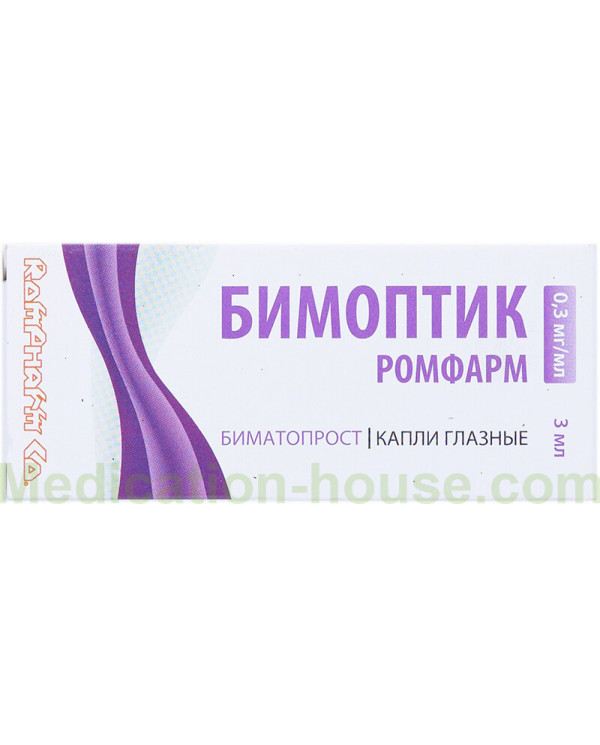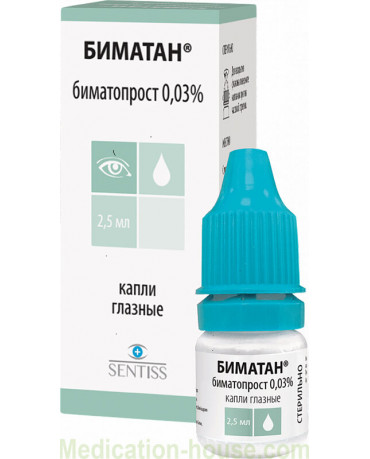Instruction for Bimoptic
Reed more and buy Bimoptic here
Composition for 1 ml of the drug
Active ingredient: bimatoprost - 0.30 mg;
auxiliary substances: citric acid monohydrate - 0.14 mg, sodium phosphate disubstituted heptahydrate - 2.68 mg, sodium chloride - 8.30 mg, benzalkonium chloride - 0.05 mg, 1 M sodium hydroxide solution or 1 M hydrochloric acid solution - to pH 7.3 ± 0.1, purified water - up to 1.0 ml.
Description: Transparent from colorless to light yellow solution.
Pharmacotherapeutic group: synthetic prostaglandin F2-alpha analogue.
Pharmacological properties
Bimatoprost reduces intraocular pressure in humans by increasing the outflow of aqueous humor through the trabecular network and increasing uveoscleral outflow.
The decrease in intraocular pressure begins approximately 4 hours after the first administration and the maximum effect is achieved approximately after 8-12 hours. The effect lasts for at least 24 hours.
Bimatoprost is a potent ophthalmic antihypertensive agent. It is a synthetic prostamide that is structurally related to prostaglandin F2a (PGF2a), which does not act via known prostaglandin receptors. Bimatoprost selectively mimics the effects of recently discovered biosynthesized substances, prostamides. However, the structure of prostamide receptors has not yet been identified.
According to clinical studies, there was no significant effect of the drug on heart rate and blood pressure.
Pediatric population
There are no data on the efficacy and safety of using Bimoptic in patients under 18 years of age.
Pharmacokinetics
Suction
Bimatoprost penetrates well into the human cornea and sclera in vitro. After instillation in adults, the systemic exposure of bimatoprost is very small, no accumulation of the drug was noted. After the introduction of one drop of Bimoptic rompharm into both eyes once a day for two weeks, the concentration in the blood reached a maximum 10 minutes after the dose was administered, and within 1.5 hours this figure was below the detection level (0.025 ng / ml). The average Cmax and AUC values of 0-24 hours were approximately the same on the 7th and 14th day - approximately 0.08 ng / ml and 0.09 ng * h / ml, respectively, indicating that a stable concentration of bimatoprost was achieved within the first week of instillations.
Distribution
Bimatoprost is moderately distributed in body tissues, and the systemic equilibrium volume is 0.67 l / kg. In human blood, bimatoprost is found mainly in plasma. Plasma protein binding of bimatoprost is about 88%.
Metabolism
Bimatoprost reaches the systemic circulation, mainly unchanged. Then oxidation, N-deethylation and glucuronidation occurs with the formation of a number of metabolites.
Withdrawal
Bimatoprost is excreted mainly through the kidneys. Up to 67% of the intravenously administered dose in healthy adult volunteers was excreted in the urine, 25% of the dose was excreted in the feces. The half-life after intravenous administration was approximately 45 minutes, the total clearance from the blood was 1.5 L / h / kg.
Indications for use
Reducing increased intraocular pressure in open-angle glaucoma and ophthalmic hypertension in adults (as monotherapy or in combination with beta-blockers).
Contraindications
Hypersensitivity to the active substance or to any of the excipients, age up to 18 years.
Carefully
Caution should be exercised when using Bimoptic Rompharm in the treatment of patients with known risk factors for macular edema (for example, in patients with aphakia, in patients with pseudophakia and rupture of the posterior lens capsule).
Bimoptic rompharm should be used with caution in patients with a history of severe eye infections (eg, caused by herpes simplex virus) or iritis / uveitis.
There is no experience with the use of bimatoprost in patients with concomitant impaired respiratory function, which requires caution in such patients. When conducting clinical studies in patients with impaired respiratory function, no significant adverse effects on the respiratory system were noted.
The effects of bimatoprost on patients with more severe first-degree heart block or on patients with uncontrolled congestive heart failure have not been studied.
Application during pregnancy and during breastfeeding
Fertility
There is no information on the effect of bimatoprost on fertility.
Pregnancy
There are no data from clinical studies of the use of bimtoprost in pregnant women. According to animal studies, reproductive toxicity has been demonstrated when used in high doses that are toxic to the mother's body.
It is not recommended to use bimatoprost during pregnancy in the absence of strict indications.
Breastfeeding period
It is not known whether bimatoprost is excreted in human breast milk. Animal studies have shown that bimatoprost is excreted in breast milk. The decision to continue / stop breastfeeding or continue / stop treatment with Bimoptic Rompharm should be taken taking into account the benefits of breastfeeding for the child and the benefits of Bimoptic Rompharm therapy for the mother.
Method of administration and dosage
The recommended dose is one drop into the affected eye (s) once a day in the evening. It is impossible to instill the drug more often than once a day, since more frequent use can reduce the effect of lowering intraocular pressure.
When using more than one ophthalmic drug for topical use, it is necessary to observe an interval of 5 minutes between the introduction of each of them.
Use in the pediatric population
Bimoptic rompharm is not recommended for use in children under the age of 18 due to the lack of data on the safety and effectiveness of the drug.
Application for hepatic and renal failure
Bimoptic rompharm has not been studied in patients with moderate to severe renal or hepatic insufficiency, so it should be used with caution in such patients. In patients with a history of mild liver dysfunction or increased levels of alanine aminotransferase (ALT), aspartate aminotransferase (ACT) and / or bilirubin in anamnesis, Bimoptic Rompharm, eye drops, 0.3 mg / ml did not have a negative effect on functional state liver for 24 months.
Side effects
The following adverse events have been observed during clinical trials and in the post-registration period.
The frequency of occurrence is given in accordance with the following classification: very often (≥1 / 10); often (≥1 / 100 to <1/10); infrequently (≥1 / 1000 to <1/100); rarely (≥1 / 10000 to <1/1000); very rare (<1/10000) and with unknown frequency (cannot be estimated from available data).
In each group, adverse effects are presented in order of decreasing severity.
Nervous system disorders
Often: headache;
Uncommon: dizziness;
Violations of the organs of vision:
Very common: conjunctival injection, itchy eyes, eyelash growth;
Often: superficial punctate keratitis, corneal erosion, burning in the eyes, eye irritation, allergic conjunctivitis, blepharitis, decreased visual acuity, asthenopia, edema of the CONJUNCTIVE, foreign body sensation in the eye, dry eye, eye pain, photophobia, lacrimation, discharge from the eyes , blurred vision, increased pigmentation of the iris, darkening of eyelashes;
Uncommon: retinal hemorrhagic disorders, uveitis, cystoid macular edema, iritis, blepharospasm, eyelid retraction, periorbital erythema;
Unknown frequency: enophthalmos.
Vascular disorders:
Often: hypertension.
Skin and subcutaneous tissue disorders:
Uncommon: hirsutism.
General disorders and disorders at the injection site:
Uncommon: asthenia.
Laboratory and instrumental research data
Often: abnormalities in the biochemical parameters of liver function.
In very rare cases, corneal calcification has been observed with the use of phosphate-containing eye drops in patients with concomitant significant damage to the cornea.
Overdose
There were no cases of overdose with topical application.
In case of overdose, treatment should be symptomatic and supportive.
Interaction
Special studies regarding the interaction of Bimoptic rompharm with other drugs have not been conducted. Interactions in the human body are not expected, since the systemic concentrations of bimatoprost are extremely low (less than 0.2 ng / ml) after instillation of the drug Bimoptic Rompharm, eye drops, 0.3 mg / ml.
In clinical studies, bimatoprost has been used concurrently with several different ophthalmic beta-blockers, but no interactions have been observed.
The simultaneous use of bimatoprost and other antiglaucoma drugs, except for ophthalmic beta-blockers, has not been studied in the course of studies of the efficacy and safety of combination therapy. There was a decrease in the hypotensive effect of bimatoprost when it was used together with other prostaglandin analogues in the treatment of ophthalmic hypertension or glaucoma.
Special instructions for Bimoptic
Before starting treatment, patients should be informed about the possibility of eyelash growth, darkening of the eyelid skin and an increase in iris pigmentation. Some of these changes can be permanent and can lead to differences in appearance between the eyes when only one eye is treated. Pigmentation changes in the iris are slow and may not be noticeable for months or years. Most often, the color change in the iris is permanent. The change in the color of the iris is more associated with an increase in melanin content in melanocytes than with an increase in the number of melanocytes. Long-term effects of increased iris pigmentation are unknown. Typically, brown pigment spreads from the area around the pupil to the root of the iris, resulting in the entire iris or parts of it becoming brownish. The use of bimatoprost has no effect on nevi and iris lentigo. Pigmentation of periorbital tissue is reversible in some patients.
There are reports of the possibility of developing cystic macular edema during the period of bimatoprost therapy, the incidence of this adverse event is infrequent ((≥1 / 1000 to <1/100), which requires caution when using the drug in the treatment of patients with risk factors for macular edema (patients with aphakia, pseudoaphakia and rupture of the posterior capsule of the lens).
Bimoptic Rompharm, eye drops, 0.3 mg / ml contains a preservative benzalkonium chloride, which can be absorbed by soft contact lenses. Eye irritation and discoloration of soft contact lenses may also occur due to the presence of benzalkonium chloride. It is necessary to remove contact lenses before instillation and put them back on 15 minutes after instillation.
Benzalkonium chloride, which is used as a preservative in eye drops, can cause punctate keratopathy and / or toxic ulcerative keratopathy. Care should be taken when using the drug in patients with dry eye syndrome, with damage to the cornea and in the case of simultaneous use of several types of eye drops containing benzalkonium chloride. It is required to control the state of the cornea with prolonged use of the drug in this category of patients.
There are reports of the possibility of developing bacterial keratitis associated with the use of reusable vials of eye drops. Dropper bottles were unintentionally contaminated by patients with concomitant eye diseases. The risk of developing bacterial keratitis was higher in patients with impaired corneal epithelial integrity. It is necessary to warn patients about the need to avoid contact of the tip of the dropper bottle with the surface of the eye and other surfaces in order to avoid damage to the organ of vision and bacterial contamination of the drug.
Influence on the ability to drive vehicles and use mechanisms
Bimoptic rompharm has a slight effect on the ability to drive a vehicle and work with mechanisms. As with the use of other eye drops, if temporary blurred vision occurs after instillation, it is necessary to wait for the patient to restore the clarity of visual perception before driving a car or operating machinery.
Release form
Eye drops 0.3 mg / ml.
2.5 ml or 3 ml of the drug in a white polyethylene bottle with a capacity of 5 ml, equipped with a drop applicator (white stopper with a dropper and closed with a white cap with a polyethylene safety ring, which ensure tightness). A label is attached to each bottle. 1 bottle with instructions for use is placed in a cardboard box.
Storage conditions
Store at a temperature not exceeding 25 ° C, in its original packaging.
Keep out of the reach of children!
The shelf life is 3 years.
After opening the bottle, the drops should be used within 4 weeks.
Do not use after the expiration date!
Terms of sell
You don't need a prescription to buy Bimoptic.


